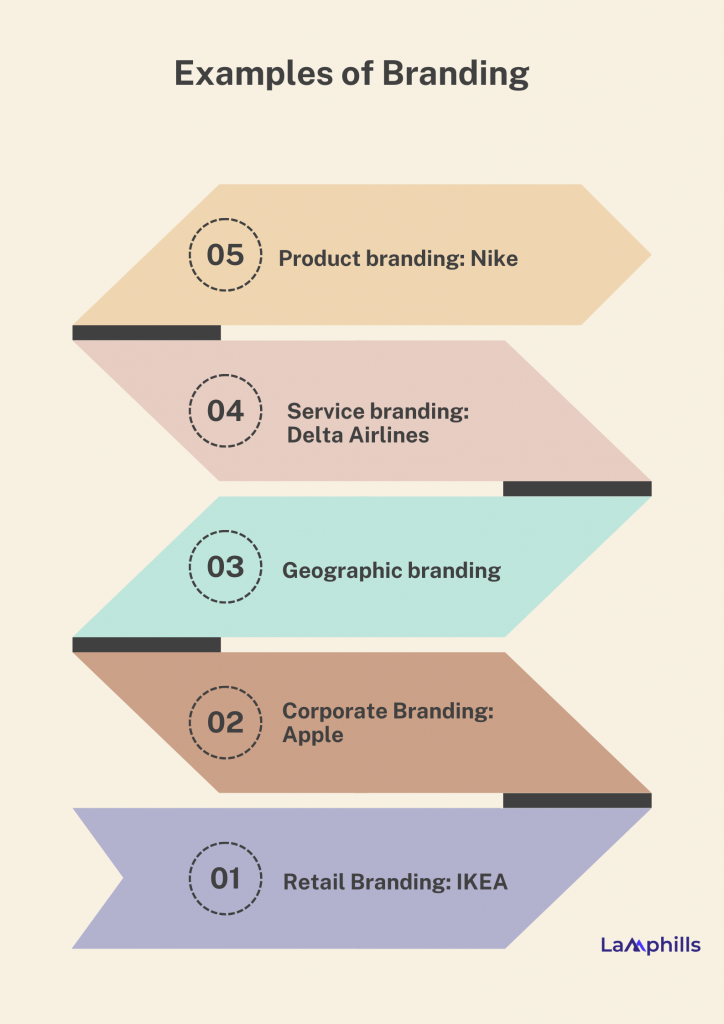Speaking of branding is more than just developing a beautiful logo; it includes messaging and design to build a brand identity and values that help people understand your company and make a favourable impression. What i am also trying to say is that your branding should trigger emotions in potential customers, allowing them to create meaningful, long-term relationships with your company. But before you’ll be able to do any of these, you should be familiar with the types of branding.
And lucky you, in this article, I will explain all you should know about branding, why it is important and the 7 types of brands based on my experience in this.
What is branding?
Branding is the set of traits that distinguish a company, organization, product, or service from competitors. Businesses frequently use unique symbols, words, names, logos, or other aspects to distinguish their brand and reflect their organization and its values. Businesses use their brand in marketing methods to gain client recognition and stand out. Customers associate specific businesses with the quality of their products and services, creating brand value.
Read Also: Branding Like a Boss: How to Make Your Brand Unforgettable
Why is Branding Important?
Branding helps you and your business become more recognized by your present and future customers. They are also used to communicate with customers by highlighting the company’s specialities and how it compares to competitors. Business owners must create a brand to market their products, services, and values to their target audience.
Competitive Analysis Template.pdf
7 Types of Branding
As I earlier mentioned, before you can understand the fundamentals of branding, you should first learn about the many types. Depending on your objectives, you can decide to employ a variety of branding techniques. Believe it or not, one company can employ numerous types of branding as long as they are consistent and can assist you in achieving your business objectives.
So here are several types of branding that could be beneficial to your business.
#1. Service Branding
Unlike certain other types of branding discussed in this article, service branding does not necessarily involve a material or tangible product but rather a service that is offered. Many services are more difficult to brand since they do not have an immediate outcome.
Let’s imagine you want to create a tutoring firm that provides various instructional services. You must persuade potential clients that your services will help them pass their test, get into college, or learn a new language (depending on the type of teacher you are). But if you don’t have students yet, how can you establish your reputation? This is where service branding demands both creativity and planning.
Because service branding is so immersive, it almost always includes client connections. Going above and beyond to provide excellent customer service will benefit your brand and its reputation. For example,ontegrating a live chat function into your website is one approach to providing real-time responses and increasing user engagement. On the same note, maintaining an active social media presence can increase awareness of your business in novel ways.
#2. Corporate Branding
Corporate branding, like product and personal branding, involves creating a brand identity for an entire business. It is the sum of a corporation’s parts rather than individual products or services. Corporate branding necessitates a thorough plan since it must consider every area of the company (or companies), including all goods, customer service, employee culture, and market influence.
When corporate branding is done correctly, it may leave a lasting impression and increase brand recognition. This is why consistency is essential in cultivating brand trust and shaping perception. Your brand values, brand messaging, brand voice, and visual brand style guide all play important roles in building
#3. Product Branding
Products are all around us, each with its character, persona, and purpose. Product branding uses smart brand colours, meaningful logos, memorable slogans, and innovative package designs to not only identify specific products but also to affect perception in the marketplace and the minds of customers.
Well-executed product branding can assist in increasing brand awareness and may persuade shoppers to choose your product based only on aesthetics. Of course, looks are not everything. Product branding is also based on emotion and the sensation that customers get when they use your brand.
Ensuring you’re reaching the correct people is critical to building a successful brand strategy.
Furthermore, understanding the psychology of colour, the power of typography, and the experience of smart design and in-person interactions should all influence your product branding selections.
#4. Retail Branding
Most of us have experienced the familiar sensation of entering into an Anthropologie store. The immediate relaxation of lit candles, bright quirky decor, and tastefully dressed mannequins—even the audio is carefully managed. Furthermore, regardless of where you come in, all stores are consistent and provide the same ambient experience. This is strategic, and it is retail branding.
For brick-and-mortar stores, providing an experience within the actual location can sometimes feel more crucial than what they offer.
Why?
Because the experiential linkage fosters brand recognition and good (or negative) associations with your brand. It all boils down to emotion and the feeling people have when they visit your store, which can’t be replicated anywhere.
#5. Personal Branding
When you think of branding, you probably link it with products or services, but a single person may also be considered a unique brand. Personal branding is exactly that. The combination of your unique skill set and experiences shapes who you are and how you interact with the world. It may also be referred to as individual branding.
Personal branding occurs across all industries but is particularly prevalent among politicians, singers, sports, fashion designers, actresses, and influencers. However, it is not limited to the wealthy and famous. Successful personal branding will make you stand out from the crowd, giving you a competitive edge to progress your career and shape people’s.
Cultivating your distinctive personal brand, like other forms of branding, will help you create trust, shape your reputation, and open up new and exciting prospects. Creating a good online resume website and employing creative social media visuals will help you develop your online presence. Being active on social media, networking with other professionals in your area, and, most importantly, remaining true to yourself are the greatest ways to develop an authentic personal brand.
#6. Offline Branding
In contrast to online branding, offline branding encompasses everything that happens offline. Even though we live in the digital age, tangible branding assets and materials such as merchandise, packaging, print ads, billboards, direct mail, bus or subway ads, and benches must be considered.
Offline marketing can also include loyalty rewards programs, contests, events, pop-up sales, and in-person encounters. Guerilla marketing tactics, which use unconventional marketing strategies and attention-grabbing stunts to bring a brand to life, can sometimes aid offline branding.
Also, offline branding transcends boundaries because it applies to all other types of branding, from personal to corporate, and requires some creative thinking to reach customers in an authentic and meaningful way. This form of branding can help increase attention and awareness in real-world settings, as well as help customers interact with your company.
Are you familiar with Starbucks’ distinctive Christmas cup? People wait all year for the specially designed mugs that signal the beginning of the holiday season. While the coffee tastes the same, the experience of sipping from the joyful cup drives sales and Instagram posts year after year.
#7. Geographical Branding
While this form of branding is frequently limited to the hotel and tourism industries, there are no hard and fast restrictions. Typically, geographical branding can function in two ways. The first is reserved for individual locales (cities, towns, countries, or regions) that aim to promote and develop tourism to help their local economies. On a large scale, it may be referred to as nation branding, or on a smaller scale, place branding.
The second category includes relatively niche products only produced in specific regions, such as avocados from Mexico or cigars from Cuba. These are known as geographical indications (GI), and they validate the origin and quality of specific products by legitimizing the place’s reputation.
Examples of Branding
Now that you’ve learned about the many branding types let’s test if you grasp how they’re applied. Here are several various types of branding examples to assist you in understanding when each one is employed.

#1. Retail Branding: IKEA
IKEA is well-known for its minimalistic yet modern and inexpensive furnishings (as well as its meatballs). Furthermore, IKEA is well-known for its low costs and extensive furniture variety, providing those wishing to equip a home with numerous options, allowing them to complete all of their shopping in one location.
#2. Corporate Branding: Apple
Apple’s corporate branding focuses on high-quality, user-friendly products. Ultimately, Apple might be called a luxury brand because its products are more expensive than those of its competitors. Anyone, including non-Apple users, can recognize Apple’s corporate branding.
#3. Geographic branding
London advertising regularly highlights Big Ben as a tourist attraction to entice visitors to book a hotel or visit the city.
Meanwhile, here is our brand style template, is a crucial tool for any startup wanting to develop its identity or a well-established corporation looking to refine its brand presence.
Brand Style Guide Template.pdf
#4. Service branding: Delta Airlines
Delta Airlines has risen to the top of the airline industry due to its dependable service and luxurious seating. Of course, everything comes with a cost, but more people will be prepared to pay more for a larger seat and better service when travelling.
#5. Product branding: Nike
Nike is one of the most popular footwear brands due to their timeless branding, which allows them to reach a wide range of customers. Their catchphrase, “Just Do It,” distinguishes them from other leading businesses in the same area.
What are the 4 models of branding?
The four C’s of branding are consumer, company, competition, and clarity. These important points are critical to building a successful branding strategy. The term “customer” relates to knowing the target audience’s demands.
What are the 4 Ps of branding?
Branding consists of four Ps: product, placement, promotion, and people. These four Ps might assist you in understanding how your brand is perceived.
Conclusion
So what are you waiting for? Start examining the various types of branding to see which one is ideal for your company today. With a little research and determination, you can develop an effective brand strategy that will help your company stand out from the competitors.
Huddle can provide experienced support in revamping your brand. Our top branding services cover everything from logo design and brand message to digital design, UX, and content, allowing you to focus on operating your business.
Related Articles
- Small Business Branding Ideas: 15 Creative Ideas for 2024
- Understanding Market Coverage: Definition, Types, and Importance for Your PR Strategy
- Become a LinkedIn Influencer with Creator Mode: A Step-by-Step Guide for Enhanced Personal Branding
- WHY IS TWITTER CALLED X NOW? Here is What the Rebranding Means
- EXTERNAL COMMUNICATION IN BUSINESS: Meaning, Types & Examples






